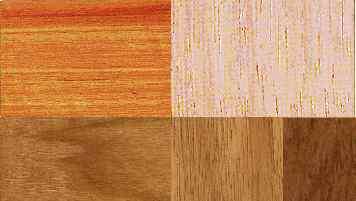
Indian Laurelwood (Terminalia celerica)
Family: Combretaceae
Common names: Chasemiich, Chieu lieu, Esemi, Indian Laurelwood, Kil, Kung, Tilautaea
Distributed in: Cambodia, China, Laos, Myanmar, Thailand, Vietnam (Oceania and S.E. Asia)
Distribution overview: Distributed throughout India and Burma, except in the dry regions of Rajasthan. It is found at elevations of up to 3000 feet (900 m), and is commonly associated with Teak (Tectona grandis) and other important timber trees.
Common uses: Beams, Boards, Boat building, Building construction, Building materials, Cabin construction, Canoes, Chairs, Chests, Concealed parts (Furniture), Concrete formwork, Construction, Core Stock, Crossties, Decks, Decorative veneer, Desks, Dining-room furniture, Dowell pins, Dowells, Drawer sides, Dressed boards, Factory construction, Farm vehicles, Figured veneer, Fine furniture, Floor lamps, Form work, Foundation posts, Framing, Furniture , Furniture components, Furniture squares or stock, Hatracks, Heavy construction, Paneling , Piling, Railroad ties, Turnery, Veneer, Wheel spokes, Wheels
Environment profile: Status has not been officially assessed
Tree size: Trunk diameter is 100-150 cm
Colors: the heart isYellow - creamy , Yellowish gray and the sapwoodWhite, Yellow.The grain isStraight, the textureUnevenand the lusterMedium
Natural durability: Susceptible to attack by insect borers , Susceptible to insect attack
Kiln Drying Rate: Very slow
Drying Defects: Distortion, Splitting
Ease of Drying: Slowly
Comments: Fruit produced by the tree is used for medicinal purposes, and occasionally for tanning and dyeing purposes
Blunting Effect: Slight dulling effect on cutting tools
Cutting Resistance: Fairly Difficult to Very Difficult to saw
Gluing: Fairly Easy to Very Easy
Nailing: Fairly Difficult to Very Difficult, Pre-boring required
Resistance to Impregnation: Responds well to preservative treatment
Response to hand tools: Smooth surfaces are difficult to obtain
Veneering qualities: Suitable for peeling, Suitable for veneers
Turning: Very Good to Excellent Results
Polishing: Very Good to Excellent;
- Numerical data Metric
- Numerical data English
- Strength properties
- References
 |
 |
 |
 |
| Item |
Green |
Dry |
Metric |
| Specific Gravity |
0,62 |
|
|
| Density |
|
544 |
kg/m3 |
| Bending Strength |
635 |
895 |
kg/cm2 |
| Crushing Strength |
369 |
566 |
kg/cm2 |
| Hardness |
|
355 |
kg |
| Impact Strength |
104 |
116 |
cm |
| Shearing Strength |
|
115 |
kg/cm2 |
| Stiffness |
113 |
137 |
1000 kg/cm2 |
| Tangential Shrinkage |
7 |
|
% |
| Radial Shrinkage |
5 |
|
% |
| Weight |
|
|
kg/m3 |
| Maximum Load |
|
|
cm-kg/cm3 |
| Toughness |
|
144 |
cm-kg |
| Static Bending |
401 |
556 |
kg/cm2 |
|
 |  |  |  | | Item | Green | Dry | English | | Bending Strength | 9045 | 12740 | psi | | Density | | 34 | lbs/ft3 | | Hardness | | 784 | lbs | | Impact Strength | 41 | 46 | inches | | Maximum Crushing Strength | 5255 | 8055 | psi | | Shearing Strength | | 1637 | psi | | Static Bending | 5704 | 7918 | psi | | Stiffness | 1610 | 1950 | 1000 psi | | Toughness | | 125 | inch-lbs | | Specific Gravity | 0.62 | | | | Radial Shrinkage | 5 | | % | | Tangential Shrinkage | 7 | | % | | Volumetric Shrinkage | 13 | | % | |
Resists denting and marring
Dense
Crushing strength = high
Compression strength (parallel to grain) = high
The species has high bending strength in the air-dry condition (about 12 percent moisture content). It compares favorably with Teak, which also has high bending strength
Desch, H. E. 1957. Manual of Malayan Timbers - Volume I. Malayan Forest Records, No. 15. Malaysia Publishing House Ltd., Singapore.Rao, K.R. and S.K. Purkayastha. 1972. Indian Woods - Their Identification, Properties and Uses, Volume III - Leguminosae to Combretaceae. Published by the Manager of Publications, Delhi, India.Troup, R.S. 1909. Indian Woods and Their Uses. The Indian Forest Memoirs, Economic Products Series, Volume 1, No. 1. Superintendent, Government Printing, Calcutta, India.
|








